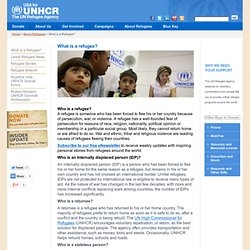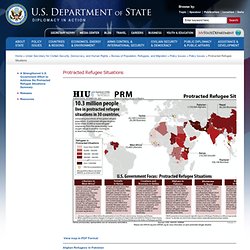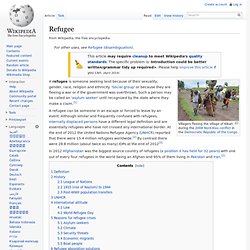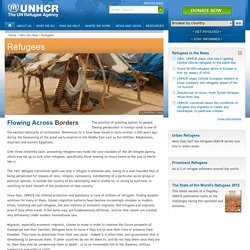

What is a refugee? What is a refugee?

Who is a refugee? A refugee is someone who has been forced to flee his or her country because of persecution, war, or violence. A refugee has a well-founded fear of persecution for reasons of race, religion, nationality, political opinion or membership in a particular social group. Most likely, they cannot return home or are afraid to do so. War and ethnic, tribal and religious violence are leading causes of refugees fleeing their countries. Subscribe to our free eNewsletter to receive weekly updates with inspiring personal stories from refugees around the world.
World Refugee Day, 20 June. The Historic Scale of Syria’s Refugee Crisis - Photographs. Gilles Peress/Magnum Photos Cristina Garcia Rodero/Magnum Photos Joachim Ladefoged/VII According to the United Nations, the flood of Syrian refugees is comparable to the crises caused by the war and sectarian violence in Iraq and by the conflicts that accompanied the breakup of Yugoslavia. In August, as many as 40,000 people hiked through the dry hills of eastern Syria to Peshkhabour, a border town in Iraqi Kurdistan.
Many refugees described a campaign by jihadi fighters to destroy agriculture and cut power and water supplies in Syrian Kurdish areas. The refugee crisis worsened once the war overtook Syria’s most populated areas. Lebanon’s population has grown almost 20 percent over the past year because of the refugee influx. In Turkey, the government houses about 200,000 refugees in tent and trailer camps, and at least 300,000 more are thought to be spread around the country. Jordan has the second-largest population of Syrian refugees. Ten things you didn’t know about refugees.
Syrian children pull water bottles at the Bab Al-Salam refugee camp in Azaz, near the Syrian-Turkish border, on June 9, 2013.

REUTERS/Hamid Khatib Today is World Refugee Day - and the latest statistics from the U.N. refugee agency (UNHCR) show world refugee numbers are higher than at any time since 1994. As U.N. refugee chief Antonio Gutteres put it at a recent news conference: “Each time you blink, another person is forced to flee.” UNHCR’s annual report shows that some 45.2 million people were uprooted by violence, persecution or rights abuses as of the end of last year, but the numbers also challenge some common misconceptions about refugees and displacement. Here are 10 things you may not have known. 1. Until you do, you’re just a person who’s been uprooted within your own country - or an internally displaced person (IDP), to use the aid world jargon. Protracted Refugee Situations. View map in PDF Format Afghan Refugees in PakistanBhutanese Refugees in NepalBurmese Refugees in ThailandRefugees from Croatia and Bosnia in SerbiaLiberian Refugees in West AfricaSomali Refugees in Kenya What is a "protracted refugee situation"?

A protracted refugee situation is one in which 25,000 or more refugees originating from the same country have sought asylum in another country (or countries) for at least five consecutive years. The Office of the United Nations High Commissioner for Refugees (UNHCR) defines protracted refugee situations as those "in which refugees find themselves in a long-lasting and intractable state of limbo. Their lives may not be at risk, but their basic rights and essential economic, social, and psychological needs remain unfulfilled after years in exile. " Why are you particularly concerned about protracted refugee situations?
Protracted refugee situations are some of the most compelling humanitarian challenges confronting governments around the world. Refugee Week Resources. USCRI. Refugee. A refugee is someone seeking land because of their sexuality, gender, race, religion and ethnicity. 'Social group' or because they are fleeing a war or if the government was overthrown.

Such a person may be called an 'asylum seeker' until recognized by the state where they make a claim.[1] A refugee can be someone in an escape or forced to leave by an event. Although similar and frequently confused with refugees, internally displaced persons have a different legal definition and are essentially refugees who have not crossed any international border. At the end of 2012 the United Nations Refugee Agency (UNHCR) reported that there were 15.4 million refugees worldwide.[2] By contrast there were 28.8 million (about twice as many) IDPs at the end of 2012[3] In 2012 Afghanistan was the biggest source country of refugees (a position it has held for 32 years) with one out of every four refugees in the world being an Afghan and 95% of them living in Pakistan and Iran.[2] Definition[edit] The U.S.
Refugees International. Refugees. © UNHCR/H.

Caux The practice of granting asylum to people fleeing persecution in foreign lands is one of the earliest hallmarks of civilization. References to it have been found in texts written 3,500 years ago, during the blossoming of the great early empires in the Middle East such as the Hittites, Babylonians, Assyrians and ancient Egyptians. Over three millennia later, protecting refugees was made the core mandate of the UN refugee agency, which was set up to look after refugees, specifically those waiting to return home at the end of World War II.